
Omega De Ville Ladies Manual Wristwatch, Ref. 511.0407, C. 1973
An Omega de Ville ladies manual wristwatch, ref. 511.0407, square brushed golden dial, applied markers, 17 jewel cal. 485 hand wind movement, gold plated stainless steel case, size 18 x 20 mm, leather band, C - 1973, working.

18ct Ladies Omega De Ville Manual Dress Wrist Watch
All 18ct ladies Omega de Ville manual dress wrist watch, gilt dial textured to match the integral mesh bracelet strap

18ct Omega De Ville Ladies Watch with Gilt Dial
All 18ct Omega de Ville manual wind ladies wrist watch, gilt circular dial on bright cut fine mesh integral strap 17.5 cm length approx. 38gms total weight

Vintage Omega and Tudor wristwatches with branded presentation box
Omega silver cased vintage wristwatch, Tudor gold cased lady's wristwatch, Omega "Seamaster" quartz wristwatch, plus an Omega branded box, (4 items)

18ct White Gold Diamond Ladies Omega Cocktail Wrist Watch
An 18ct white gold and diamond ladies Omega cocktail wrist watch, four round brilliant cut diamonds, batons for numbers, black leather cord strap, in working order.

Omega 18ct Yellow Gold Ladies Dress Watch, Manual Wind Movement
Ladies Omega 18ct yellow gold dress watch marked Omega 750 marks to the clasp. Approx weight 40 grams ex movement, 15 cm length, manual wind movement working when tested

Vintage Omega 18ct Yellow Gold Watch, 1960s, 17 Jewel Movement
Ladies Omega 18ct yellow gold watch C.1960s marked clasp & case omega 750 marks. movement 620 17 jewel working when tested. Approx weight grams, ex movement. Engraved: MP 22 12 66

Vintage 14ct Yellow Gold Omega Ladies Wristwatch with Mesh Strap
A vintage 14ct yellow gold ladies Omega wristwatch, the circular dial with baton makers, 14ct gold mesh strap. 20.1gms. Running.

18ct Yellow Gold Omega Ladies Watch with Mesh Bracelet
Ladies 18ct yellow gold Omega watch, case and bracelet in 18ct yellow gold. Mesh style bracelet. Round 19 mm diameter case. Gold coloured dial. Total weight including movement 30.1 grams.

Omega 18ct Ladies Wristwatch - Serial No. 13039086 (Not Running)
Omega 18ct ladies wristwatch. Serial No.13039086. Without movement. Not running. (W36.36g)

9ct Gold Plated Omega Ladies Cocktail Wristwatch, Manual Wind Movement
9ct gold plated, 17 mm Omega manual wind ladies cocktail wristwatch. Cream coloured signed index dial. Gold plated Omega winder. Manual wind movement. Case is presented on a 8 mm black strap with pin buckle. In working order. Watch only.

Omega 18ct Gold Lady's Watch with Textured Links, Manual Wind
Omega, 18ct gold lady's watch, manual wind, with open textured links, signed to dial and bracelet, stamped 750, weight bracelet with additional links 46.0gm, gross weight 51.0gm, length 16 cm.

Omega 14ct Yellow Gold Lady's Pocket Watch with Enamel Dial
Omega, yellow gold lady's pocket watch, 14ct yellow gold, white enamel dial with black Arabic numerals, and gold hands, signed to the dial 'Omega', manual wound movement, case signed 'Omega' and stamped '56, 14K', engine turned case with central vacant…

Omega 18ct Yellow Gold De Ville Watch, c. 1970
Omega, lady's 18ct yellow gold de Ville watch, c. 1970, hexagonal shaped case, gold dial with baton markers at 12,3,6 and 9, manual wound movement to a solid gold integral mesh bracelet and buckle, signed 'Omega' to dial, movement and buckle, stamped '18K…

Vintage Ladies Omega Mechanical Watch, Cal. 484 Movement, 15mm Case
Ladies Omega mechanical watch marked Omega to the crown, case & movement. Cal. 484 movement working when tested. Case width 15 mm

Omega De Ville Ladies Quartz Wristwatch, Gold Plated, Leather Band
An Omega de Ville ladies quartz wristwatch, in gold plated stainless steel, brushed golden dial, on 3 jewel movement, case width 19 mm, leather band, scratched glass, not tested, needs battery.
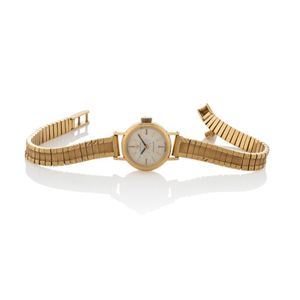
Omega Ladies Vintage 18ct Gold Watch with Matching Bracelet
Omega ladies vintage wristwatch in 18ct gold case with 18ct gold Omega bracelet, stamped '750'
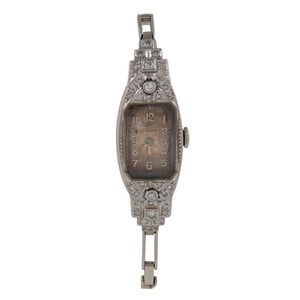
Platinum and diamond Art Deco lady's wristwatch, circa 1930s
Omega fine Art Deco lady's wristwatch in platinum and diamond case, circa 1930s

Omega Ladies 9k Gold Watch with 18ct Bracelet, Manual Movement
Ladies Omega yellow gold watch marked: case Omega 9k, bracelet; 750, manual movement Omega cal: 483. Approx weight ex movement 22.48 grams (est. 3 grams 9ct), case width 16 mm, bracelet length 16 mm, working when tested. Minor dog eared wear to the strap,…

Vintage Omega Deville Ladies Watch, Stainless Steel & 18ct Gold
Stainless steel and 18ct yellow gold, vintage, 22 mm, ladies Omega Deville quartz wristwatch. Silver index signed dial with gold coloured indices and hands. Stainless steel case with gold tone bezel on a stainless steel bracelet with gold tone links and…

Vintage Omega Seamaster Automatic Watch, 23mm Case Width, Working Condition
Ladies Vintage Omega Seamaster automatic watch approx case width 23 mm, working when tested, the strap is not a branded example, approx case width 23 mm, working when tested, the strap is not a branded example

Omega Constellation Ladies Wristwatch, Mother of Pearl Dial, Stainless Steel
Ladies Omega constellation wristwatch, quartz movement, in stainless steel with mother of pearl dial and stud hour markers, with fixed Roman numeral bezel, marked to rear of case 'My Choice', #57357692, case diameter 24 mm, with Omega stainless steel band…

14ct Omega Ladies Dress Watch with Diamond Set on Mesh Strap
14ct Omega ladies dress manual wrist watch, oval silvered dial with leaf blade shoulders diamond set on stainless steel double feathered mesh strap 18 cm long

Omega Seamaster Aqua Terra 18ct Gold Diamond Ladies Watch
Omega Seamaster aqua Terra Ref 23125302055001 a lady's 18ct gold, stainless steel and diamond-set watch with date and bracelet Sold 2010. Dial: white mother of pearl, applied gilt circled diamond hour markers, date aperture at 3. Calibre: cal. 8520…

Vintage 9ct Gold Ladies Omega Watch with Champagne Dial
A vintage 9ct gold ladies Omega watch; ref. 2859 with champagne dial, applied markers, 17 jewel cal. 244 hand wind movement, case size 19 mm, generic band, C- 1958, working, with box.

Omega Constellation Ladies Watch with Diamond Bezel and Mother-of-Pearl Dial
Omega constellation watch, ladies 18k and stainless steel with diamond bezel and diamond mother of pearl dial. In good working condition
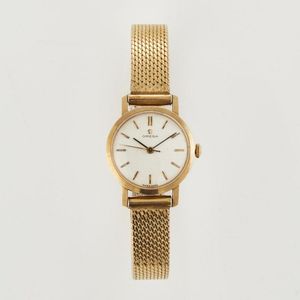
Vintage Omega 22mm 9ct Yellow Gold Ladies Manual Wind Watch
Vintage, Omega, 22 mm, 9ct yellow gold ladies manual wind wristwatch. A classic lady?s model, this wristwatch has a solid 9ct yellow gold case on a stainless steel gold plated bracelet (non - original) model ref Bl 531 5002. Manual wind, this model is…

Omega De Ville Ladies Quartz Watch, Steel & Gold, Ref 7474.11.00
Stainless Steel/Yellow gold, 23 mm ladies Omega de Ville classic quartz wristwatch. Ref 7474.11.00. Calibre: Omega 1471 quartz movement. Gold coloured dial with gold tone Roman numeral hour markers. Steel and gold case and bracelet with stainless steel…

Omega Ladies 14ct Gold Wristwatch with Triple Rope Bracelet
A ladies Omega 14ct yellow gold wristwatch, with original Omega triple rope strand 14ct yellow gold bracelet. The oval case with Roman numerals to the quarters. Swiss made. 22gm. In original Omega box.

Vintage Omega Ladies Wristwatch with Tropical Dial, 18ct Gold
A vintage 18ct gold Omega ladies wristwatch, ref. 511.136 with tropical dial, applied baton markers, hand wind 17 jewel cal. 620 movement with 2 adjustments, size 20 mm, pull through grosgrain band, working, C - 1965.

Omega Constellation Ladies Watch with Diamond Bezel and Mother-of-Pearl Dial
Omega constellation watch, ladies 18k and stainless steel with diamond bezel and diamond mother of pearl dial. In good working condition

Omega 'Deville' lady's automatic wristwatch on 18ct gold band
Omega 'Deville' lady's automatic wristwatch on 18ct yellow gold band, circa 1960, bracelet weight (minus movement) 38 grams

Vintage Omega Gold Ladies Watch with Mesh Bracelet and Box
Omega, gold ladies watch, Ref OA7110036: vintage 9ct gold watch, silver dial, gold baton numerals & hands. Manual-wound, signed Omega dial & movement. Gold mesh bracelet with 0.375 stamped buckle, engraved back, not working, total weight 23grams. Omega…

Omega 18ct Gold Lady's Watch with 17 Jewel Movement
Omega, 18ct gold lady's watch manual wind 17 jewel movement, numbered 25488682, the textured dial with baton hour markers, to polished and elongated tonneau from case with to integrated woven strap with folding clasp, signed to dial, movement, case and…

Omega Ladies 9ct Rose Gold Manual Wind Watch, Engraved Back
Ladies Omega 9ct rose gold watch manual wind movement running when tested. Rubbed 9ct marks, case width 15 mm, estimated case weight 3 grams, engraved to the back

1970 Omega Ref 10648 Lady's Gold Bracelet Watch
Omega Ref 10648 a lady's gold bracelet watch circa 1970; dial: silvered, applied hour markers; calibre: cal. 213 manual winding, 17 jewels; movement number: 14050214; case: 18ct gold textured square, snap on back; case number: 11248544; closure: 14ct gold…

18ct White Gold Omega De Ville Ladies Dress Watch
All 18ct white gold Omega de Ville ladies manual wind dress wrist watch, tight woven mesh bracelet strap with a bright cut textured finish 17-18 cm length

Diamond-set Omega Ladies Cocktail Watch
Omega, diamond set ladies cocktail watch, 18ct white gold round case claw set with single cut diamonds, silver dial with silver baton markers and black hands, dial and movement signed Omega, manual wound movement, on a black cord band to a stainless steel…
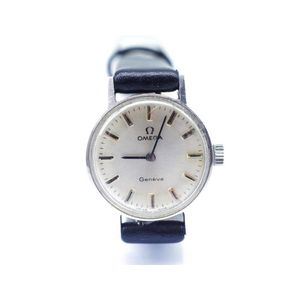
Vintage Ladies Omega Cocktail Watch, 568 Cal. Movement, 20mm Case
Ladies Omega cocktail watch mechanical wind 568 cal. Movement running when tested, case width 20 mm

Omega Diamond Bracelet Watch, 1970
Omega a lady's 18ct white gold and diamond-set bracelet watch circa 1970. Dial: silvered, applied hour markers and diamond quarters. Calibre: cal. 620 manual winding, fully jewelled. Movement number: 31068157. Case: brushed oval, diamond-set bezel, snap…
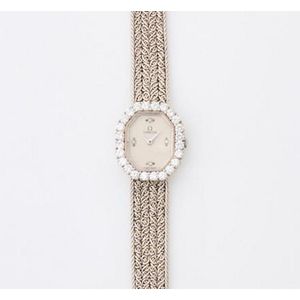
Diamond-set Vintage Omega Ladies Watch
A vintage ladies Omega cocktail watch with 18ct white gold case and bracelet. Diamond set bezel. Cream white dial with 4 x diamonds. Omega signed clasp on bracelet. Swiss Omega quartz movement. Currently not working, May need a battery replacement.…
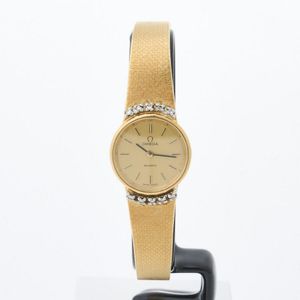
Vintage Omega Ladies Watch with Diamonds and Gold
An Omega ladies vintage watch with 18ct yellow gold case and bracelet. Swiss quartz movement with original box. Case set with 10 x diamonds. Champagne index dial with sapphire crystal. Case diameter approximately 20 mm.

Omega De Ville Ladies Quartz Watch on Leather Strap
C1980 Omega de Ville quartz ladies stainless steel wrist watch, case 24 mm dia on original leather strap (very worn)

Omega 14ct Ladies Mesh Strap Dress Watch
Omega 14ct ladies manual dress wrist watch, silvered dial on integral fine heavy mesh strap approx 35gms
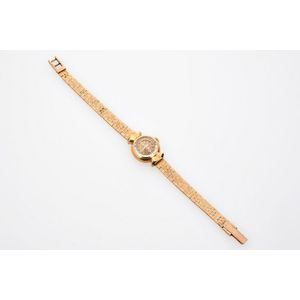
Omega Ladies' Watch, 1930s, 18K Gold, Textured Bracelet
Omega, Ladies' watch, circa 1930s, 18ct yellow gold circular case with ribbon style lugs, with manual wound movement, discoloured champagne dial, with textured gold brick style bracelet, stamped '18K', good working order, 23.6 grams, case 17 mm
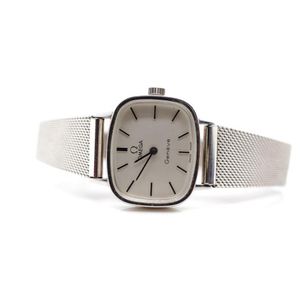
Vintage Omega Watch with GF Mesh Bracelet
Ladies vintage Omega watch marked Omega cal:625 mechanical wind movement working when tested. Approx case width 24 mm. On a GF mesh bracelet
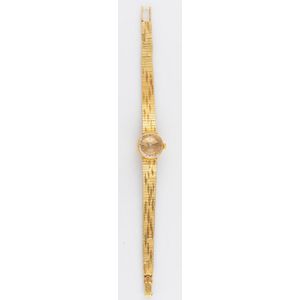
Omega Ladies 18ct Yellow Gold Wristwatch
A ladies Omega gold Wristwatch, Manual wind, circular gold dial with applied baton numerals, 18ct yellow gold case and integral bands, signed case, dial, movement and bands, total weight 36.5gms, 17 mm diameter, total length 190 mm.

Omega Diamond Constellation Ladies Watch
A ladies Omega diamond constellation Wristwatch, Automatic, circular black dial with diamond numerals and date at three, diamond set bezel to stainless steel case with glazed section to reverse, stainless steel bands, 18 mm diameter, boxed.

Omega Ladies Gold Watch with Champagne Dial
An Omega 18ct gold plated ladies wristwatch; sunburst champagne dial, applied baton markers, manual wind movement, case size 18 mm, leather band, some wear to plating, working.
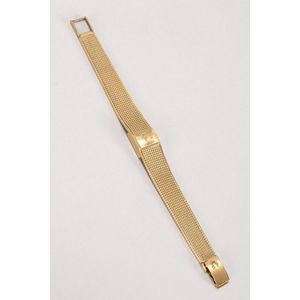
18ct Gold Ladies Omega Wristwatch with Mesh Band
Ladies Omega 18ct gold wristwatch, marked 750 to band clasp and 18k/750 to inner rear case, Swiss made, #833838/8109, movement #22787953, with rectangular brushed gilt dial set with baton hour markers, original 18ct yellow gold mesh band, total gold…
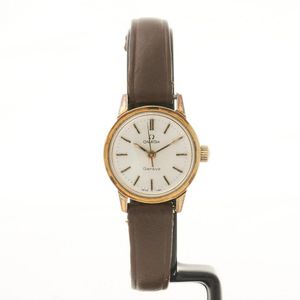
1960's Omega Geneve Ladies Watch
Vintage ladies Omega Geneve circa 1960's. yellow gold plated case with brown leather strap. Automatic movement. Original Omega signed yellow gold plated pin buckle. Omega signed crown. Approximate case diameter 28 mm. E any seals been tested on…

18ct Gold Omega Constellation Ladies Watch with Date
Omega constellation Ref 1382 a lady's 18ct gold bracelet watch with date, dial: sunburst champagne, applied Roman numeral hour markers, date aperture at 3, calibre: quartz, case: brushed and polished tonneau form, black bezel, snap on back, Closure: Omega…
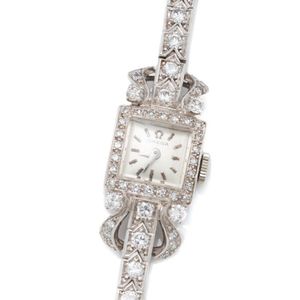
Platinum & Diamond Omega Lady's Wristwatch with 78 Diamonds
A vintage Omega lady's diamond wristwatch, square platinum case with stylised Omega lugs and bezel set with 40 round brilliant and single cut diamonds on a 17 jewell cal. 213 manual movement, to an 18ct white gold link bracelet (non Omega) set with 38…
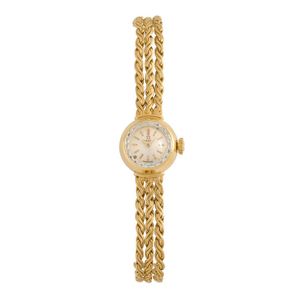
Omega 18ct Gold Bracelet Watch, Circa 1960
Omega Ref 7049D a lady's 18ct gold bracelet watch circa 1960, dial: silvered, raised baton hour markers, calibre: cal. 483 manual winding, 17 jewels, movement number: 17915265, case: polished circular, snap-on back with inscription N.E.H 8-6-63, case…

Diamond-set Omega ladies wristwatch, 18ct and 9ct white gold
Antique 18ct white gold Omega ladies wrist watch with diamond set case and 9ct white gold band, 16.4g total, diameter of face 1.7 cm, untested, May require a service
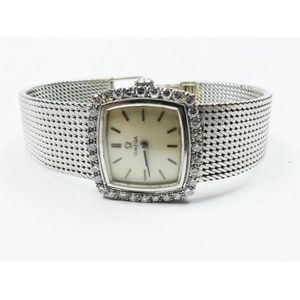
18ct White Gold Omega Watch with Diamond Bezel
White gold Omega watch this ladies 18ct gold watch with a diamond set bezel 32= 0.96ct GH colour Si clarity, with off white dial, reference 860707, calibre 620, white gold case and mesh bracelet, case measurements 23 x 24 mm, 49.9 grams total weight…

Girard Perregaux Ladies White Gold Watch 17 Jewel Mechanical
Ladies Girard Perregau x 18ct white gold watch mechanical wind mechanism marks 17 jewel 57194**, Girard Perregaux, case 750 Helvetia Girard Perregaux. Omega crown, clasp 750GP, weight 43 grams ex movement, case width 16.5 mm, length 15 cm, with extra…
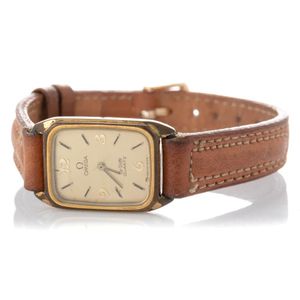
Gold Plated Quartz Ladies Watch with Leather Band
An Omega de Ville ladies quartz wristwatch; in gold plated stainless steel, brushed golden dial, on 3 jewel movement, case width 19 mm, leather band, working, scratched glass.

9ct Gold Omega Lady's Watch, 2cm Wide
Omega lady's watch in 9ct gold case, 2 cm wide including crown
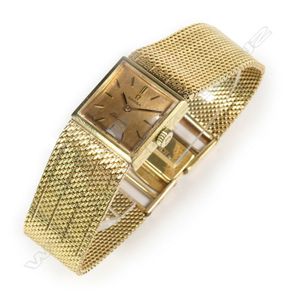
1960s Omega Ladymatic 18ct Gold Mesh Strap Watch
A 1960s Omega Ladymatic 18ct gold lady's wristwatch, with integral mesh strap. Total 61.12gm

Diamond Omega Wristwatch with 0.60ct & 18K Band
Ladies diamond set Omega wristwatch, Omega branded set with 2 round brilliant cut, 34 single cut & 6 bacquette cut diamonds. Band marked 18K, diamond weight around 0.60ct total weight 182.7g. Provenance: Deceased Estate, Sydney.

10ct Rolled Gold Omega De-Ville Ladies Watch with Matching Band
Omega De-Ville ladies wrist watch, 10ct rolled gold with matching mesh 10ct rolled original gold band
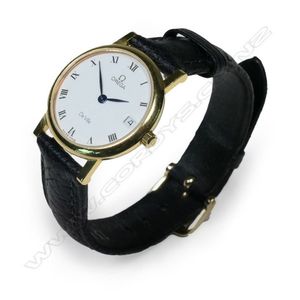
Omega De Ville Ladies Watch with Warranty Card
A lady's Omega 18ct yellow gold de Ville wristwatch, white enamel dial with Roman numerals and date aperture, black stitched leather strap. The back # 53690539. With grey leather wallet enclosing warranty card dated 22-02-93.

Omega and Seiko Quartz Wristwatches, Untested
Lady's Omega and Seiko quartz wristwatches; Omega de Ville with tonneau shape silver tone dial with gold plated case on later band, and Seiko, ref; 2C20-0050 with round gold tone dial and gold plated stainless steel case on original crocodial band (worn),…
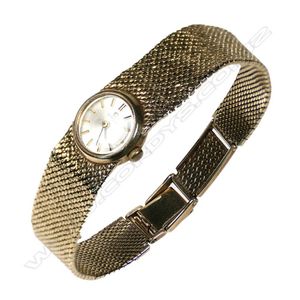
Omega 9ct Yellow Gold Wristwatch with Mesh Strap
A c.1950s, lady's Omega 9ct yellow gold wristwatch, the silvered dial with baton hour markers and maker's name, stylish 9ct gold mesh strap. Working but strap showing signs of wear, 24.96gm excluding movement.

18ct Omega De Ville Ladies Automatic Watch with Mesh Strap
All 18ct Omega de Ville automatic ladies wrist watch gilt circular dial with baton indices on tight mesh integral strap

Vintage Omega Lady's Wristwatch with Gold Sunburst Dial
A vintage 9ct gold Omega lady's wristwatch, ref. OA2637 with sunburst dial, applied baton markers, on 17 jewel cal. 620 manual wind movement with 2 adjustments, case diam. 20 mm, cord band worn, C- 1965, working.
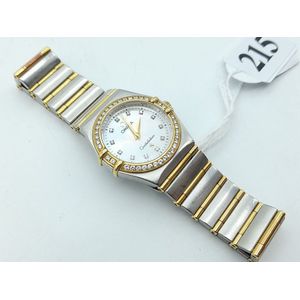
Diamond-studded Omega Constellation Watch for Ladies
Omega constellation watch, ladies 18k and stainless steel with diamond bezel and diamond mother of pearl dial. In good working condition

Sapphire and Diamond Omega Bangle Watch
A vintage lady's Omega sapphire and diamond cocktail watch, designed as a tapered hinged bangle, diamond set bezel, bullet markers, set with sapphires and baguette and round brilliant cut diamonds, tapered angular design, diamonds totalling 1.10cts,…

Genuine Two-Tone Omega Constellation Ladies Watch with Date
Omega ladies wrist watch, Genuine two-tone gold and stainless steel 'Constellation' with date
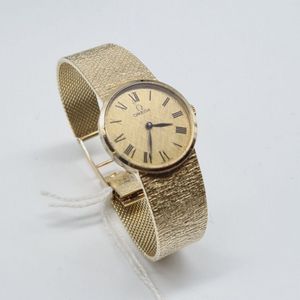
Vintage 14ct Ladies Omega Wrist Watch - Working Condition
Ladies Omega wrist watch, 14ct yellow gold case, back and band vintage ladies wrist watch in excellent original working condition

Vintage Omega Watch, Gold Plated, Working (1974)
A ladys vintage Omega wristwatch, ref. 711.2022 gold plated stainless steel, round silvered dial, applied baton markers, 17 jewel cal. 625 manual movement, case diameter 24 mm, integrated gold plated band, boxed, c1974, working.

Omega 18ct White Gold Diamond Wristwatch, 1973
Omega Ref. 8127 18ct white gold and diamond lady's wristwatch with silvered dial, 1973, manufacturer: Omega, year: 1973, reference no.: 8127, movement no.: 26632128, case no.: B 06261, model: 8127, material: 18ct white gold and diamonds, calibre: manual,…

Omega Diamond Quartz Watch with Guilloche Black Dial
An Omega constellation lady's diamond quartz wristwatch, in stainless steel with guilloche black dial, single cut diamond markers, lume hands, Omega 5 jewel cal. 1376 quartz movement, cased dia. 27 mm, integrated band, new battery, working.

Vintage Omega Ladies Diamond Watch
A vintage Omega ladys 18ct white gold diamond wristwatch, round dial, applied markers, bezel and lugs set with 2 round brilliant cut and 28 single cut diamonds on a 17 jewel cal. 483 manual wind movement to a cord band, case diam. 17 mm, C - 1961, working.
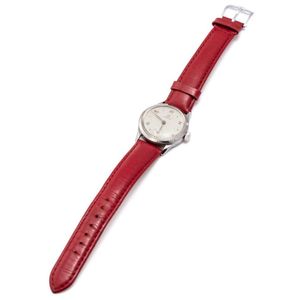
Vintage Omega Lady's Wristwatch, 1950
A vintage Omega lady's wristwatch, in stainless steel, matte dial, subsidiary seconds, 15 jewel manual movement, cal. 26.5T3 case diam. 19.6 mm, leather band, working. C-1950.

Running Omega Ladies 17 Jewel Wristwatch - Calibre #483
Omega ladies wristwatch. Cold case ladies 17 jewel calibre #483 wristwatch. Running.

Vintage Omega Deville Ladies Watch with Rolled Gold Band
A vintage Omega ladies wrist watch with rolled gold band, 'Deville' with original leather band 9Spare and box

18ct Omega Yellow Gold Cocktail Watch
Ladies 18ct Omega a small cocktail watch in 18ct yellow gold case, back case and bracelet. Manual movement. In working order with a total weight including movement of 29.6 grams.

Gold Pocket and Cocktail Watches, Working Movements
A small 9ct pocket watch in 14ct yellow gold case missing winder. Movement working, total weight with movement 35.5 grams. Ladies 18ct Omega a small cocktail watch in 18ct yellow gold case, back case and bracelet. Manual movement. In working order with a…
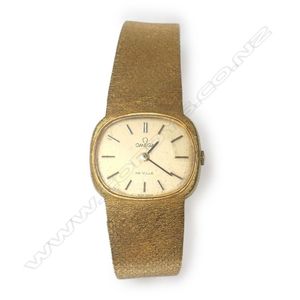
1960s Omega De Ville 18ct Gold Lady's Wristwatch with Strap
A 1960s Omega de Ville 18ct gold lady's wristwatch, with integral mesh strap. Manual calibre 620 movement. Total 60.4gm

Vintage Omega Ladies White Gold Mechanical Watch
Ladies white gold Omega watch with a mechanical wind movement working when tested. Approx case width 15 mm, with a later stretch band, discoloured dial, movement is tight in case. Circa 1950s. Tests as 9ct to the case

Ladies Omega Cocktail Watch Set, Serviced & Working
Ladies Omega cocktail watch and group with a stainless steel case 20 mm, working when tested in box, as well as another marked Omega and a quartz piece. All approx. Has been serviced

Omega Constellation 18ct Yellow Gold Ladies Watch
Omega constellation 18ct yellow gold ladies watch marked 750, Omega to dial, crown and clasp. With a fret work fancy strap. Approx length 16 cm, weight 33.6 grams, movement 700, Serial 25909***. Mechanical wind movement working when tested

Vintage Omega De Ville Watch and Silver Bracelet Set
Ladies vintage Omega de Ville watch and sterling silver chain bracelet. Marked Omega to the dial crown and slide clasp, approx case width 30 mm, bracelet width 23 mm, length 16 cm, weight 70 grams, movement 8272, serial 35943***, mechanical wind movement…

Vintage Omega Lady's Gold Watch, Not Working
A vintage Omega 9ct gold lady's wristwatch, guilloche dial, applied markers, generic crown, case diam. 17 mm, gold filled band, not working.

Vintage Omega 14ct Gold Lady's Wristwatch, Working
A vintage Omega 14ct gold lady's wristwatch, brushed champagne dial, applied markers, 17 jewel cal. 482 manual movement, case diam. 17 mm, cord band, C - 1960, working.

Mixed Watch Lot: Omega, DKNY, Citizen, Seiko, Rodania, Not Working
Ladies Omega watch and watch group includes a mechanical wind 17 jewel cal. 485. (working when tested. As well as DKNY, Clyda, Citizen, Classique and Seiko quartz examples not working, and a Rodania. not working

Vintage Omega Diamond & White Gold Watch
Ladies vintage Omega diamond and white gold watch cal: 244, 17 jewels mechanical movement. 18ct white gold case marked Omega and a 9ct white gold with JC&S, 375, Birmingham 1959. weight ex movement 18.5 grams (18ct 3 grams), length 14-16.5 cm adjustable.…

1970s Omega Dynamic Sports Watch with Original Buckle Clasp
Ladies Omega 'Dynamic' automatic sports watch circa 1970s, automatic movement working when tested. case width 30 mm. With the original buckle clasp

Omega and Girard Perregaux Ladies Watches with Mechanical Movement
Ladies Omega and Girard Perregaux watches includes Omega cal. 484 and a 17 jewel mechanical wind examples

18ct Gold Diamond-Set Omega Constellation Bracelet Watch
Omega constellation a lady's 18ct gold and diamond-set bracelet watch, circa 2000 dial: brushed, gilt and diamond-set calibre: 1450 quartz case: brushed, tonneau-form with diamond-set bezel, secured by four screws, with Geneva Observatory emblem to…

Omega De Ville Lady's Wristwatch, 1973
An Omega de Ville Lady''S manual wristwatch; in stainless steel with rectangular case, brushed silver dial, 17 Jewell movement integrated band, case width 16.3 mm, length 20 cm, C-1973.

Vintage Omega Lady's Wristwatch, 1953
A vintage Omega Lady''S wristwatch; in stainless steel with round dial, heart shape lugs, 17 jewell manual movement, case diam. 18.8 mm, Handley band, C, 1953.

Vintage Omega Ladies Watch, Dynamic Geneve (1960s)
Vintage Omega ladies watch Dynamic Geneve. Working when tested. Approx case width 29 mm, needs a pin for the gold plated steel bracelet. Circa late 1960s

Omega Ladymatic Rose Gold Ladies Watch on Gold Chain
Omega Ladymatic 18ct rose gold 17-jewel ladies wrist watch, Swiss made with silvered dial, set on 9ct gold chain link band 21.5g
 Loading more...
Loading more...